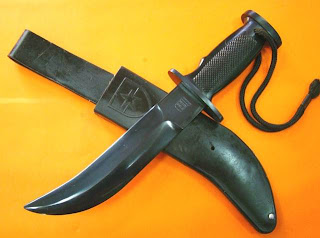Death of the Prince impérial during the Anglo-Zulu War, by Paul Jamin.
Throughout the 19th century, British troops in Africa regularly met their ends on the blades of the assegais of Zulu warriors. In one of the most noteworthy incidents, the Prince Imperial, only son of Napoleon III, was stabbed to death while serving a tour with the British military.
Here is how is demise is described at Wikipedia:
The Prince took part in several reconnaissance missions, though his eagerness for action almost led him into an early ambush, when he exceeded orders in a party led by Colonel Redvers Buller. Despite this on the evening of May 31, 1879, Harrison agreed to allow Louis to scout in a forward party scheduled to leave in the morning, in the mistaken belief that the path ahead was free of Zulu skirmishers.
On the morning of June 1, the troop set out, earlier than intended, and without the full escort, largely owing to Louis's impatience. Led by Carey, the scouts rode deeper into Zululand. Without Harrison or Buller present to restrain him, the Prince took command from Carey, even though the latter had seniority. At noon the troop was halted at a temporarily deserted kraal while Louis and Carey made some sketches of the terrain, and used part of the thatch to make a fire. No lookout was posted. As they were preparing to leave, about 40 Zulus fired upon them and rushed toward them screaming. The Prince's horse dashed off before he could mount, the Prince clinging to a holster on the saddle - after about a hundred yards a strap broke, and the Prince fell beneath his horse and his right arm was trampled. He leapt up, drawing his revolver with his left hand, and started to run - but the Zulus could run faster.
The Prince was speared in the thigh but pulled the assegai from his wound. As he turned and fired on his pursuers, another assegai struck his left shoulder. The Prince tried to fight on, using the assegai he had pulled from his leg, but, weakened by his wounds, he sank to the ground and was overwhelmed; when recovered, his body had eighteen assegai wounds and stabbed through the right eye which had burst it, and penetrated his brain. Two of his escort had been killed and another was missing. Lt. Carey and the four men remaining came together about fifty yards from where the Prince made his final stand—but not a single shot did they fire at the Zulus. Carey led his men back to camp, where he was greeted warmly for the last time in his career: after a court of inquiry, a court martial, intervention by the Empress Eugenie and Queen Victoria, he was to return to his regiment a pariah, shunned by his fellow officers for not standing and fighting. Carey endured several years of social and regimental opprobrium before his death in Karachi, India, on February 22, 1883.
Louis Napoleon's death caused an international sensation, and in one slanderous account Queen Victoria was accused of deliberately arranging the whole thing. The Zulus later claimed that they would not have killed him if they had known who he was. Zabanga, his chief assailant, met his death in July at the Battle of Ulundi. Eugénie was later to make a pilgrimage to Sobuza's kraal, where her son died. The Prince, who had begged to be allowed to go to war (taking the sword carried by the first Napoleon at Austerlitz with him) and who had worried his commanders by his dash and daring, was described by Wolseley as "a plucky young man, and he died a soldier's death. What on earth could he have done better?"














